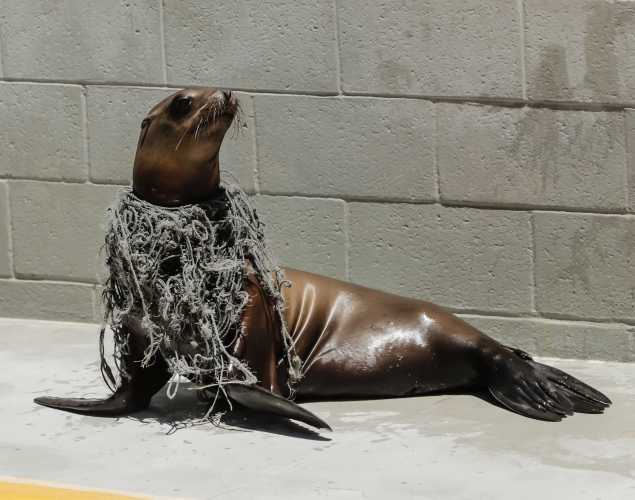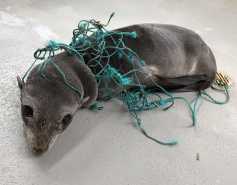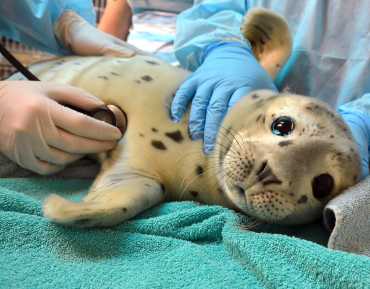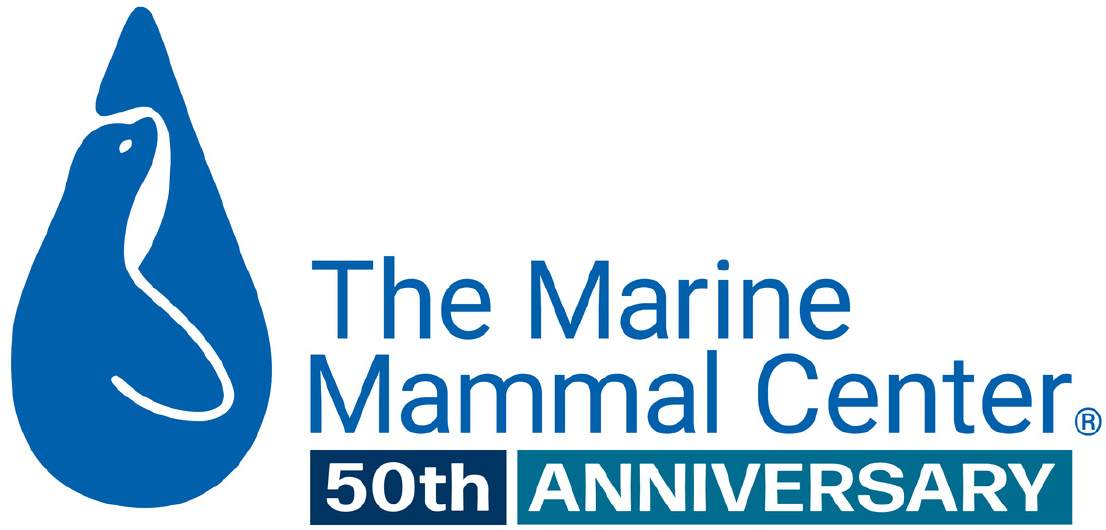
Severe Life-Threatening Entanglements Have Experts Concerned
- Species conservation
- Entanglement
A Series of Severe Life-Threatening Entanglements on Marine Mammals Has Experts Concerned
The Marine Mammal Center – the Largest Marine Mammal Hospital in the World – Has Found that the Impact of Ocean Trash and Fishing Gear Entanglements Threatens the Recovery of Species Like the Threatened Guadalupe Fur Seal
A series of entanglements of marine mammals along the California coast are especially concerning for the long-term recovery of threatened and endangered species. Since June 1, The Marine Mammal Center – the largest marine mammal hospital in the world – has admitted eight Guadalupe fur seal and California sea lion patients to its Sausalito hospital suffering from varying types of entanglements, a condition that, if left untreated, can lead to the inability to find food, severe lacerations and death.
While this year’s numbers of patients are consistent with past years, the severity of entanglements recently seen on threatened Guadalupe fur seals has Center veterinarians concerned. Entanglements, along with other significant ecosystem disruptions marine mammals are facing, including the impacts of overfishing and warming waters due to climate change, complicates the animal’s survival rates.
“Trash and plastic pollution in our ocean impacts seal and sea lion patients we rescue each year, as well as large cetaceans such as whales,” says Dr. Cara Field, Medical Director at The Marine Mammal Center. “It’s especially alarming to see these preventable entanglements in Guadalupe fur seals because this species is still recovering from the brink of extinction.”
It’s especially alarming to see these preventable entanglements in Guadalupe fur seals because this species is still recovering from the brink of extinction.
Listed as a threatened species under the Endangered Species Act, the Guadalupe fur seal has the highest prevalence of entanglement in marine debris of any marine mammal the Center rescues. According to two major entanglement studies published in 2009 and 2017 by Emma Moore and Daniela Bárcenas de la Cruz, respectively, approximately 25 percent of Guadalupe fur seals admitted into the Center’s care from 2001-2015 were suffering from the effects of ocean trash entanglements.
Guadalupe fur seals spend most of their life far offshore. This makes researching the elusive animal more difficult and is a key reason why the Center works closely with partners in Mexico to investigate the life history of this species. Researchers like Tenaya Norris, a scientist at the Center, are collecting valuable data from animals at their main breeding site to investigate where they travel in the ocean, how much time they spend on land, and how many are in the population each year.
Learn More
{"image":"\/Animals\/Patients\/Guadalupe fur seals\/2018\/cropped-images\/gfs-snaggle-by-cara-field-c-the-marine-mammal-center-noaa-permit-18786-376-0-3571-2789-1602455471.jpg","alt":"Guadalupe fur seal Snaggle","title":"Severe Entanglements Threaten Recovery of Guadalupe Fur Seals","link_url":"https:\/\/www.marinemammalcenter.org\/news\/severe-entanglements-threaten-recovery-of-guadalupe-fur-seals","label":"News Update","date":"2020-08-14 05:00:00","type":"news"}

{"image":"\/Animals\/Wild\/Hawaiian monk seal\/hawaiian-monk-seal-in-fishing-gear-shutterstock.jpg","alt":"Hawaiian monk seal tangled in fishing gear","label":"Conservation","title":"Ocean Trash","link_url":"\/science-conservation\/conservation\/ocean-trash","type":"page"}

{"image":"\/Animals\/Patients\/Guadalupe fur seals\/2018\/gfs-snaggle-by-dana-angus-c-the-marine-mammal-center-noaa-permit-18786.jpg","alt":"Guadalupe fur seal patient Snaggle","label":"Pinnipeds","title":"Guadalupe Fur Seal","link_url":"\/animal-care\/learn-about-marine-mammals\/pinnipeds\/guadalupe-fur-seal","type":"page"}

This June, two male pups, Neshema and Dansam, were transported to the Center’s Sausalito hospital to recover from severe entanglements in netting gear as well as malnutrition. As one of only two facilities permitted to provide long-term rehabilitative care for Guadalupe fur seals in California, the two animals were transferred to the Center in June from partners at the Northcoast Marine Mammal Center in Crescent City, CA. After spending six weeks in rehabilitation to boost body condition and overall weight, the duo was recently released back to the wild in Point Reyes National Seashore.
Solving the issue of ocean trash and plastic entanglements is critical because it disproportionally impacts young seal and sea lion patients the Center cares for like Neshema and Dansam. Entanglements, due to human sources of marine debris such as packing straps or fishing gear, cause life-threatening constrictions around the heads, necks and bodies of marine mammals as they grow.
Intelligent and curious, seals and sea lions can see trash as something to eat, investigate or play with—not knowing that this new object could end up being fatal. While entanglements affect all age classes, the Center’s research shows younger animals appear to be more susceptible than adults. Seals and sea lions are most frequently entangled around the head and body in monofilament fishing line, net fragments, packing straps, rope and rubber products.
Another recent rescue case that illustrates the devastation an entanglement can have on a marine mammal’s life was a young California sea lion named Pascal. A yearling female, this emaciated sea lion was rescued in July and brought to the Center with a severe monofilament fishing line through her mouth and around her head.
During her admission exam, veterinarians noted that the entanglement had affected her ability to eat for several weeks and left her extremely debilitated. After removing the entanglement, Center experts took a series or radiographs, or x-rays, of Pascal’s head that showed a severe lower jaw fracture and infection. As a result, Center veterinarians made the difficult decision to humanely euthanize Pascal.
“This young animal’s death is a vivid example of how ocean trash wreaks havoc on a marine mammal,” says Dr. Field. “Knowing this animal not only suffered the direct pain of a broken jaw and the tight entanglement, but continued to suffer and slowly starve for weeks to months is absolutely heartbreaking.”
The Marine Mammal Center has been on the front lines of marine mammal rescue and rehabilitation for more than 45 years, and has the expertise and tools needed to save these animals. Demand is growing each year for the Center’s support and training of organizations and individuals worldwide in effective rescue and entanglement response. This critical need led to the Center’s Global Response Training Institute successfully supporting and training its first partner organization in La Paz, Mexico.
We want to not only share our entanglement response expertise widely to support the recovery and treatment of entangled marine mammals worldwide but also identify and reduce these occurrences.
“We want to not only share our entanglement response expertise widely to support the recovery and treatment of entangled marine mammals worldwide but also identify and reduce these occurrences,” says Dr. Field. “Ocean trash knows no international boundaries so it’s critical as the world’s largest marine mammal hospital that we help support and build the network of response organizations dedicated to tackling the issue of ocean trash and the conservation of these important species.”
To learn more about The Marine Mammal Center and how to support the recovery of patients suffering from entanglements, text OCEAN to 41444 to donate or visit MarineMammalCenter.org/donate to help the Center perform its life-saving work.
Donations allow the Center’s experts to:
- Use innovative rescue tools to capture wild, entangled animals using advanced sedation, tracking and rescue techniques.
- Perform complicated surgeries to repair injuries caused by entanglements.
- Train veterinarians and animal experts from countries developing rehabilitation and conservation programs so they can rescue and treat entangled animals on their own coastlines.
For more information or to set up an interview on this topic, please contact us at media@tmmc.org.
Yes, I want to save a life!

Yes, I want to save a life!
You’ll be giving sick and injured animals the best possible care at the Center’s state-of-the-art hospital. With your gift today, you are giving a patient a second chance at life in the wild.
See Our Latest News
{"image":"\/Animals\/Patients\/Hawaiian monk seals\/2025\/cropped-images\/d-ru28release-exam-at-ke-kai-ola111025photo-by-giancarlo-rulli-c-the-marine-mammal-center-noaa-permit-24359-0-0-1270-992-1764620886.jpg","alt":"","title":"Bird Flu Vaccine Trial Offers Hope for Protecting Hawaiian Monk Seals","link_url":"https:\/\/www.marinemammalcenter.org\/news\/bird-flu-vaccine-trial-may-offer-hope-for-protecting-hawaiian-monk-seals","label":"News Update","date":"2025-12-01 08:13:00"}

Bird Flu Vaccine Trial Offers Hope for Protecting Hawaiian Monk Seals
December 1, 2025
Read More{"image":"\/Animals\/Patients\/Hawaiian monk seals\/2021\/hms-pp08-by-sheila-latta-c-the-marine-mammal-center-noaa-permit-18786.jpg","alt":"Hawaiian monk seal","title":"The New York Times: Inside the Bird-Flu Vaccine Trial for Monk Seals","link_url":"https:\/\/www.marinemammalcenter.org\/news\/the-new-york-times-inside-the-bird-flu-vaccine-trial-for-monk-seals","label":"In the News","date":"2025-12-01 01:00:00"}

The New York Times: Inside the Bird-Flu Vaccine Trial for Monk Seals
December 1, 2025
Read More{"image":"\/Animals\/Wild\/Sea otter\/so-wild-morro-bayphoto-c-brian-simuro-20.jpeg","alt":"Sea otter and pup","title":"Watch a Sea Otter Pup Reunite With Its Mother","link_url":"https:\/\/www.marinemammalcenter.org\/news\/watch-sea-otter-pup-reunite-with-its-mother","label":"News Update","date":"2025-11-14 10:35:41"}

{"image":"\/Animals\/Wild\/Sea otter\/sea-otter-photo-c-brian-simuro.jpeg","alt":"Sea otter","title":"AP News: Baby sea otter is reunited with mother in central California after dramatic rescue","link_url":"https:\/\/www.marinemammalcenter.org\/news\/ap-news-baby-sea-otter-is-reunited-with-mother-in-central-california-after-dramatic-rescue","label":"In the News","date":"2025-11-14 09:46:34"}

AP News: Baby sea otter is reunited with mother in central California after dramatic rescue
November 14, 2025
Read More
